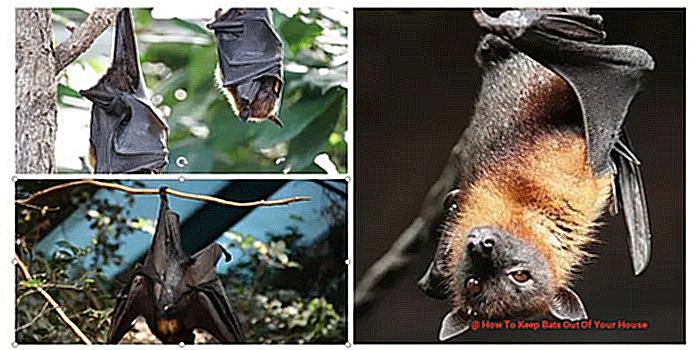Are you exhausted from dealing with bats invading your home and causing chaos? While these creatures may play a crucial role in our ecosystem, they can become quite a nuisance when they decide to make your house their home.
From creating noise and mess to posing health risks with their droppings and potential for carrying diseases, having bats in your living space is not ideal. So how can you keep them out? Here are some effective methods to consider:
- Seal all entry points: Bats can squeeze through even the tiniest openings, so it’s essential to seal any gaps or cracks in your walls, roof, or chimney.
- Install bat houses: Providing an alternative shelter for bats away from your home can discourage them from roosting inside.
- Use deterrents: Certain scents like peppermint oil or mothballs can repel bats. You can also install ultrasonic devices that emit high-frequency sound waves that irritate bats.
- Keep lights off at night: Bats are drawn to light sources, so keeping your outdoor lights off at night will lessen their interest in your house.
- Seek professional help: If you’re dealing with a severe bat infestation, it’s best to seek assistance from a wildlife control expert who can safely remove the bats and seal off entry points.
By implementing these methods, you can effectively keep bats out of your house and maintain a peaceful living environment. Don’t let these winged creatures take over; take action now before it becomes a bigger problem. Remember, prevention is key when it comes to keeping bats out of your home. So don’t wait until it’s too late; start implementing these strategies today for a bat-free tomorrow.

Table of Contents
Why Should You Remove Bats?
Having bats living in your house can pose several dangers, including exposure to illnesses, contamination of the environment, and structural damage. Therefore, it is crucial to remove them from your home for the following reasons:
- Health Hazards: Bats are known carriers of diseases such as rabies, histoplasmosis, and other parasites that can be harmful to humans. These illnesses can be transmitted through bites, scratches, or contact with bat droppings and urine. Moreover, bat guano and urine can also cause respiratory issues and leave a strong odor.
- Contamination: The accumulation of bat droppings and urine can contaminate the surroundings, making it unsafe for both humans and pets. This can also result in damage to property, leading to expensive clean-up procedures.
- Structural Damage: Bats typically roost in attics, roofs, insulation, and wiring, causing extensive harm to the structure of a home. This can result in costly repairs and even pose a fire hazard.
- Prevention of Re-infestation: Removing bats from your house is essential to prevent future infestations. If not properly excluded, bats may return to their previous roosting spot or find another entry point into your home.
In conclusion, it is imperative to eliminate bats from your house to protect yourself, your family, and your property from potential health risks, contamination, and structural damage.
Professional Bat Exclusion
- Discover access points: Carefully observe bat behavior during dusk to pinpoint where they are entering and exiting the house.
- Temporary closure: Utilize a material that permits bats to escape but restricts them from returning to temporarily seal off entry points.
- Implement exclusion devices: Install professionally-made exclusion devices at each access point to allow bats to exit but not re-enter.
- Sanitize and disinfect: Wear protective gear and meticulously clean and disinfect any areas where bats have left droppings or urine.
- Seal all possible entryways: Repair any cracks and gaps in walls, windows, and roofing. Place screens or mesh over vents and chimneys.
- Utilize deterrents: Along with physical barriers, consider using motion-activated lights or sound devices to discourage bats from approaching your house.
- Seek professional help: It is highly recommended to enlist the services of a professional bat exclusion company for their expertise and proper tools to ensure successful exclusion.
DIY Bat Removal
“DIY Bat Removal” is not as simple as it may seem, but there are a few effective and safe methods you can try to remove bats from your house. Here are some tips to get you started:
- Seal Entry Points: The first step is to identify and seal any gaps or cracks in your house that bats could use as entry points. This can be done using materials such as caulk, wire mesh, or foam insulation. By blocking these openings, you prevent bats from entering your home.
- Use Exclusion Devices: Another method that has proven effective is the use of exclusion devices. These allow bats to exit the house but prevent them from re-entering. One popular exclusion device is the one-way door, which is placed over the bat’s entry point and allows them to fly out but not back in.
- Try Natural Repellents: If you prefer a more natural approach, certain scents like peppermint, eucalyptus, and citronella can be used around potential entry points to deter bats. However, these may need to be reapplied regularly and may vary in effectiveness depending on the type of bat species.
- Use Sound-Based Deterrents: Ultrasonic devices emit high-frequency sounds that are unpleasant for bats and can drive them away. These can be used in combination with other methods for best results.
Remember to handle the removal process with caution and care, wearing protective gear and avoiding harm to the bats.
Invest In and Install a Bat House
Investing in and installing a bat house can offer numerous advantages, not only for preventing bats from entering your home but also for the ecosystem and agriculture.
- Attracts Bats to Your Yard: By setting up a bat house, you are providing a secure and suitable habitat for bats to roost. This can help lure bats away from your house and into your yard.
- Natural Pest Control: Bats are valuable for managing common household pests like mosquitoes, moths, and beetles. They can also consume crop pests, reducing the need for harmful pesticides.
- Pollination: Certain bat species play a crucial role in pollination, contributing to the diversity and health of local ecosystems.
- Disease Control: Bats greatly contribute to controlling mosquito populations, which can carry diseases such as Zika virus. By attracting bats to your yard, you are indirectly helping to prevent the spread of these diseases.
- Conservation: Investing in and installing a bat house can support the conservation of these beneficial creatures. Bats are currently facing an epidemic called white nose syndrome, and providing them with suitable roosting habitats can help ensure their survival.
- Safe Removal: If you have bats living in your house, installing a bat house can provide a safe and humane way to remove them from your home while still allowing them to live nearby.
- Eco-Friendly: By using natural methods, such as installing a bat house, for pest control instead of harmful chemicals, you are promoting a more eco-friendly approach to managing pests.
Aside from these benefits, investing in and installing a bat house can also offer educational opportunities for children and adults alike to learn about the significance of bats in our ecosystem and how we can support their conservation efforts.
Our Rating Methodology
| Our Rating Methodology | Explanation |
| Effectiveness | We evaluate how well a solution works in keeping bats out of houses, taking into consideration factors such as the type and severity of infestation. We also look at the success rates reported by other homeowners who have used the solution. |
| Safety | We consider the humaneness and potential risks or hazards associated with each solution, ensuring that they do not harm bats or other animals. |
| Cost | We assess the initial cost and ongoing maintenance expenses to determine the overall value for money of each solution. |
| Convenience | We evaluate the level of expertise, effort, and time required to implement and maintain each solution, considering factors such as DIY options and professional services. |
When it comes to finding solutions to keep bats out of houses, there are several important criteria that must be considered. Our rating methodology takes into account four main factors – effectiveness, safety, cost, and convenience – to accurately rate each solution.
- Effectiveness: We thoroughly evaluate how well a solution works in keeping bats out of houses. This includes considering the type and severity of the bat infestation, as well as the type of house. We also take into account the success rates reported by other homeowners who have used the same solution.
- Safety: As bats are protected species that play an important role in our ecosystem, it is crucial to use humane and non-lethal solutions that do not harm them or other animals. We carefully assess the potential risks and hazards associated with each solution, including any chemicals or devices that may pose a threat to children or pets.
- Cost: Our rating methodology also considers the overall cost-effectiveness of each solution. This includes not only the initial cost but also any ongoing maintenance or replacement expenses. By comparing the cost with effectiveness, we can determine the value for money of each solution.
- Convenience: We understand that different homeowners may have varying levels of expertise and preferences when it comes to implementing and maintaining solutions. That’s why we evaluate the level of expertise, effort, and time required for each option, taking into account DIY solutions and professional services.
By using these criteria in our rating methodology, we provide readers with accurate and relevant information based on our subject matter expertise and personal experience.
Conclusion
To wrap things up, having bats take up residence in your home can be a frustrating and potentially dangerous situation.
However, with the methods outlined in this article – such as sealing entry points, installing bat houses, using deterrents, and seeking professional assistance – you can effectively keep these winged creatures out of your living space. It is crucial to remove bats from your home to avoid health hazards, contamination, structural damage, and future infestations.
Moreover, investing in a bat house not only benefits you but also contributes to the ecosystem. When considering solutions for keeping bats out of houses, it is essential to assess their effectiveness, safety, cost-efficiency, and convenience.
By following these strategies and utilizing our rating methodology to guide your decision-making process, you can create a peaceful living environment free from bat invasions.





